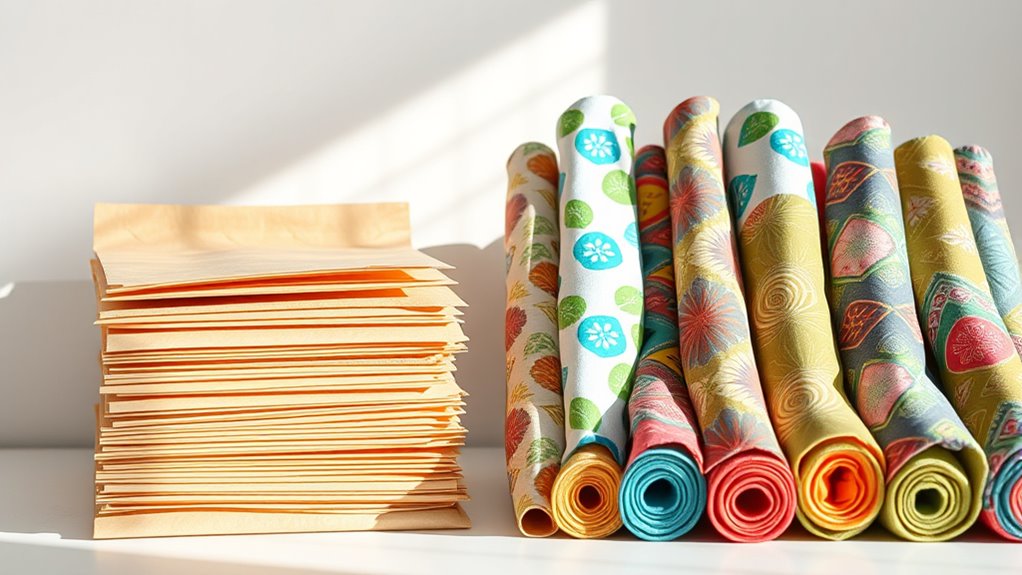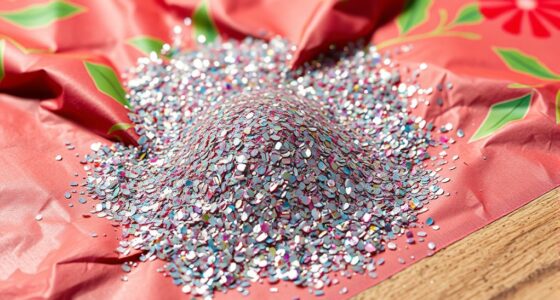If you’re looking for sustainable alternatives to bubble wrap, consider options like biodegradable packing peanuts, recyclable paper bubble wrap, or molded pulp packaging made from recycled fibers. You can also use corrugated cardboard sheets, reusable air pillows, or upcycled materials like fabric scraps and old newspapers. Mushroom-based packaging and plant-based foam offer eco-friendly durability, while recyclable bubble wrap films help reduce plastic waste. Keep exploring to discover more eco-smart packaging solutions that protect your items and the planet.
Key Takeaways
- Recyclable paper bubble wrap with air pockets offers eco-friendly shock absorption and decomposes naturally.
- Molded pulp packaging made from recycled paper and plant fibers provides biodegradable and durable protection.
- Biodegradable foam alternatives crafted from plant-based materials or agricultural waste reduce environmental impact.
- Upcycled and repurposed materials like cardboard, fabric scraps, or old newspapers serve as sustainable cushioning options.
- Biodegradable packing peanuts that dissolve in water enable eco-conscious shipping without plastic pollution.
Biodegradable Packing Peanuts
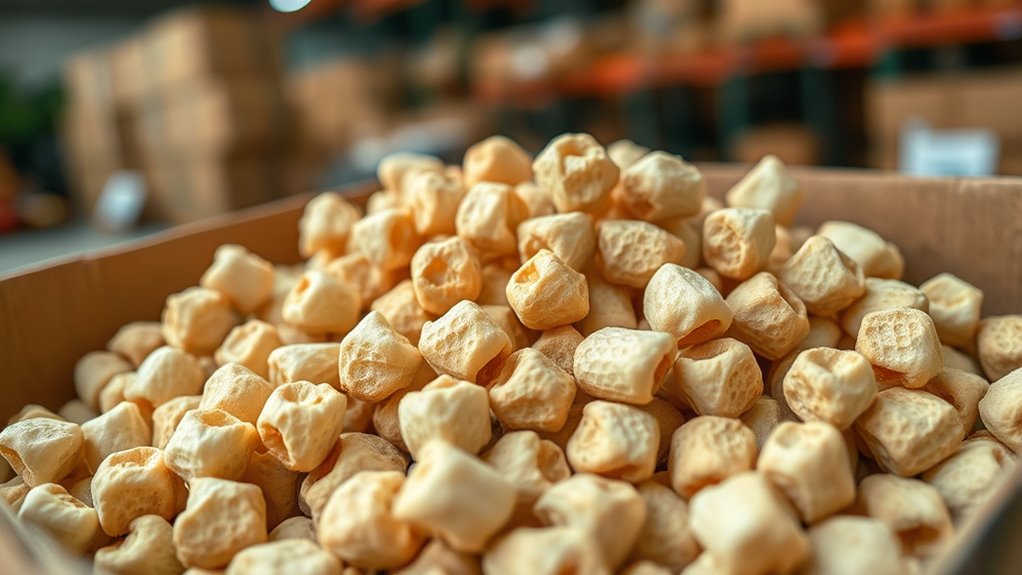
Biodegradable packing peanuts offer an eco-friendly alternative to traditional polystyrene foam. They improve shipping efficiency by providing excellent cushioning that absorbs shocks and protects your items during transit. These peanuts easily conform to various shapes, reducing the need for excess filler and streamlining packing processes. When comparing costs, biodegradable peanuts often match or are slightly more affordable than their non-biodegradable counterparts, especially considering environmental benefits. They dissolve in water, eliminating disposal issues and reducing waste management expenses. This makes them a practical choice for businesses aiming to lower their carbon footprint while maintaining cost-effectiveness. Additionally, their ability to influence cellular regeneration in biological systems promotes smoother operations and better customer satisfaction. Overall, biodegradable packing peanuts deliver reliable protection with an eco-conscious approach, balancing shipping efficiency and cost comparison effectively.
Recyclable Paper Bubble Wrap
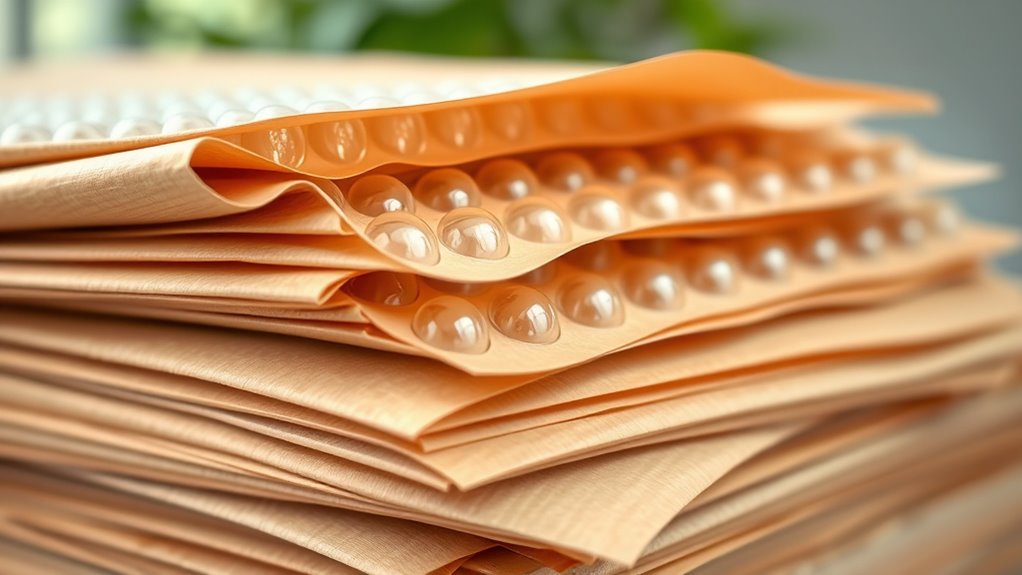
Recyclable paper bubble wrap offers a sustainable alternative to traditional plastic bubble wrap, providing effective cushioning while being environmentally friendly. Made from sturdy, recyclable paper, this bubble wrap mimics the protective qualities of plastic versions without the plastic waste. It’s designed with air pockets that absorb shocks and prevent damage during transit, making it ideal for packaging fragile items. Because it’s recyclable paper, you can easily dispose of it through your local recycling programs, reducing landfill waste. Unlike plastic bubble wrap, it doesn’t contribute to microplastic pollution or take centuries to decompose. Using recyclable paper bubble wrap not only safeguards your products but also supports your commitment to eco-friendly practices, helping you lower your carbon footprint while maintaining efficient packaging standards. This eco-conscious material also reduces the reliance on fossil fuels used in plastic production, further emphasizing its sustainability benefits. Additionally, biodegradable packaging ensures the material breaks down naturally, minimizing environmental impact and supporting environmental sustainability.
Molded Pulp Packaging
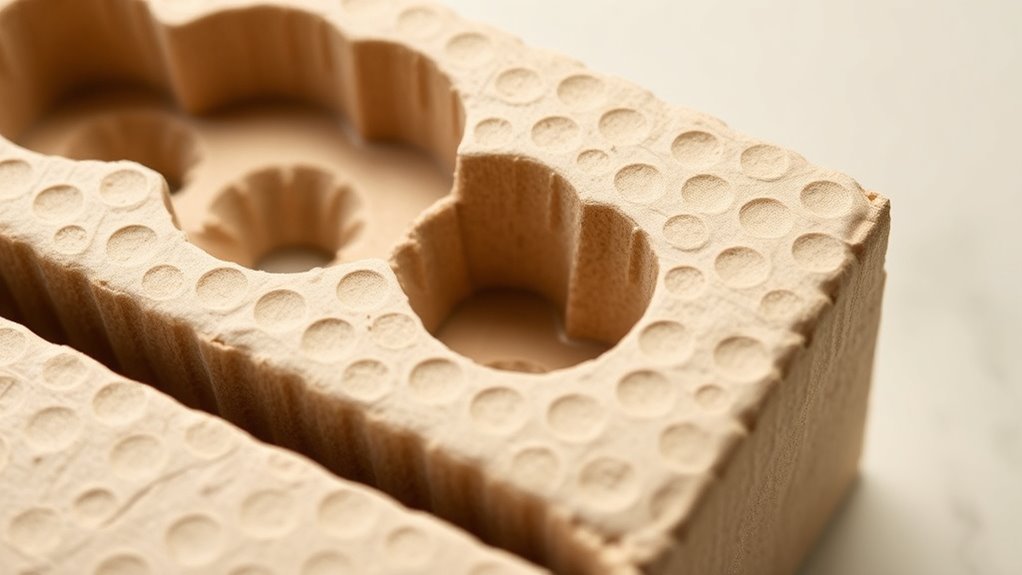
Molded pulp packaging offers a biodegradable and compostable option that can break down naturally in the environment. It’s made from sustainably sourced materials, reducing reliance on virgin resources. Plus, it provides solid protective performance and durability, making it a reliable alternative for shipping fragile items. Additionally, its manufacturing process can incorporate environmental impact considerations, further enhancing its sustainability profile. Many designs utilize self-watering plant pots principles to improve efficiency and reduce waste during production, showcasing innovative approaches within sustainable packaging.
Biodegradability and Composting
Have you ever wondered what happens to packaging materials after you discard them? Molded pulp packaging offers a clear answer. It’s designed to break down through chemical decomposition, transforming into natural components without leaving harmful residues. Unlike plastics, molded pulp is biodegradable, meaning it naturally decomposes in the environment over time. Its marine biodegradability ensures it can decompose even in aquatic settings, reducing pollution and harming aquatic life less. When composted properly, molded pulp turns into nutrient-rich soil, completing its eco-friendly cycle. This process not only minimizes waste but also supports sustainable waste management. Biodegradable packaging materials are increasingly being adopted to lessen environmental impact. By choosing molded pulp, you’re helping to reduce landfill accumulation and promoting materials that naturally return to the earth. Regular use of biodegradable packaging materials aligns with the principles of environmentally friendly and sustainable practices.
Material Sourcing and Sustainability
Choosing sustainable packaging options starts with understanding where materials come from. Molded pulp packaging is a great alternative because it’s made from recycled paper and plant fibers, reducing reliance on synthetic fibers. When sourcing, check if the supplier uses eco-friendly practices, avoiding chemical treatments that can harm the environment. Additionally, consider the environmental impact of the entire supply chain to ensure truly sustainable choices.
Consider these points:
- Opt for pulp materials sourced from sustainably managed forests.
- Ensure manufacturing processes avoid harmful chemical treatments.
- Favor suppliers committed to low-impact, recyclable, and biodegradable packaging options.
- Incorporate sound design principles into packaging to enhance user experience and brand perception.
Protective Performance and Durability
While molded pulp packaging offers a sustainable alternative to traditional bubble wrap, its protective performance depends on proper design and material quality. You need to guarantee the material strength is sufficient to withstand impacts during transit. Well-designed molded pulp inserts provide effective shock absorption, cushioning your items from sudden jolts. The durability of molded pulp also plays a key role; it must resist crushing and maintain its shape over time. When these factors are optimized, molded pulp can protect fragile goods just as well as conventional packaging. Proper manufacturing techniques and quality control are essential to maximize its protective capabilities. Additionally, understanding Kia Tuning options can help optimize the overall protection and presentation of vehicle parts during shipping. Selecting high-quality molded pulp is crucial for ensuring impact resistance and overall durability, which can significantly reduce product damage. Ultimately, choosing high-quality molded pulp ensures your products are safe while reducing environmental impact.
Corrugated Cardboard Sheets and Folds
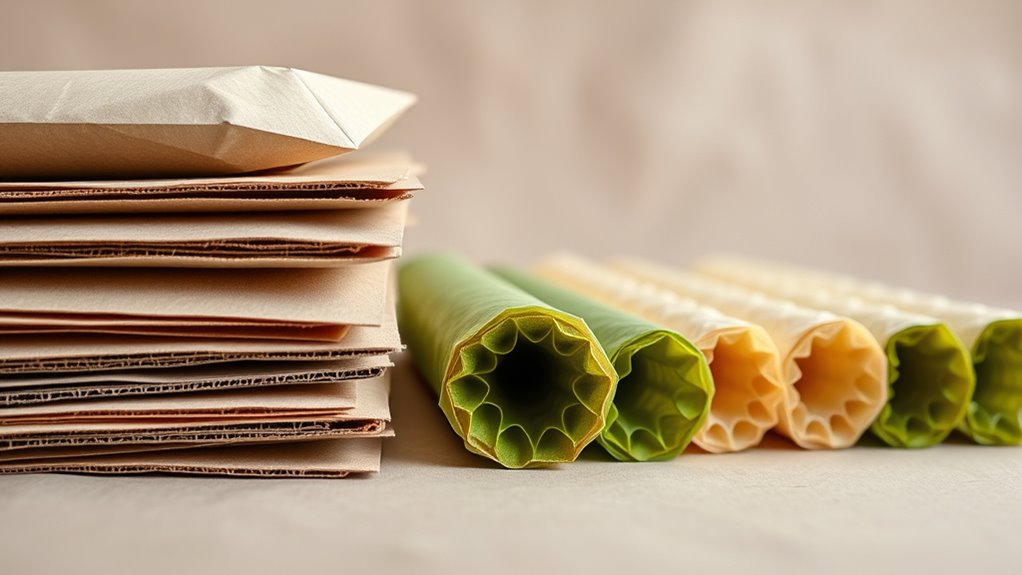
Corrugated cardboard sheets and folds offer a durable and eco-friendly way to protect your items during transit. You can customize these layers to fit your specific cushioning needs, reducing waste and improving efficiency. By choosing this material, you support sustainable packaging practices while ensuring your goods stay safe. Incorporating wide color gamut can also help you evaluate and optimize your packaging supplies, preventing unnecessary excess. Additionally, selecting recyclable materials aligns with market demand for eco-friendly solutions, enhancing your company’s sustainability profile.
Durable Cushioning Material
Corrugated cardboard sheets and folds serve as a highly effective, durable cushioning alternative to traditional bubble wrap. They provide excellent shock absorption and air cushioning, protecting fragile items during transit. You can easily customize these sheets to fit various shapes and sizes, making your packaging more versatile. Here are some benefits:
- Reusable and recyclable, reducing waste.
- Strong enough to absorb impacts, safeguarding your products.
- Cost-effective, especially for bulk packaging needs.
– Their layered structure distributes force evenly, preventing damage from shocks and vibrations. Unlike bubble wrap, cardboard folds can be folded, cut, or layered for tailored protection. Additionally, their impact resistance makes them suitable for various shipping needs. Plus, they’re lightweight, so you won’t add extra weight to shipments. By choosing corrugated cardboard, you make your packaging more sustainable without sacrificing durability. Furthermore, the variety of materials available allows for customization to meet specific cushioning requirements.
Eco-Friendly Material Choice
Choosing corrugated cardboard sheets and folds is an eco-friendly way to protect your items without relying on plastic-based bubble wrap. Its innovative design offers strong cushioning while minimizing waste, making it a sustainable choice. Corrugated cardboard is often made from recycled materials, reducing environmental impact and promoting reuse. Its surfaces can be easily folded or cut to fit various shapes, providing versatile protection. Additionally, it’s chemical-safe, ensuring no harmful substances leach onto your products or the environment. This material is biodegradable and recyclable, making disposal simple and eco-conscious. By opting for corrugated cardboard, you support sustainable practices and reduce your reliance on non-biodegradable plastics, all while maintaining effective protection through innovative design. Incorporating recyclable packaging materials into your packaging process further enhances your commitment to environmental responsibility. Utilizing biodegradable alternatives helps minimize landfill waste and supports a healthier planet. Furthermore, choosing materials with recycled content can significantly lower the carbon footprint of your packaging.
Customizable Protective Layers
Because of its versatile design, corrugated cardboard sheets and folds can be easily customized to fit a wide range of items and shapes. This makes them ideal for creating customizable protective layers that suit your specific packaging needs. With tailored packaging designs, you can ensure your items are well-protected while reducing waste. Here are some ways you can utilize this material:
- Cut and fold sheets to match the exact dimensions of your products.
- Layer multiple sheets for added cushioning and shock absorption.
- Use scoring techniques to create custom folds that secure fragile items perfectly.
- Incorporate goal setting principles to plan your packaging solutions efficiently and sustainably.
Air Pillows Made From Recyclable Materials
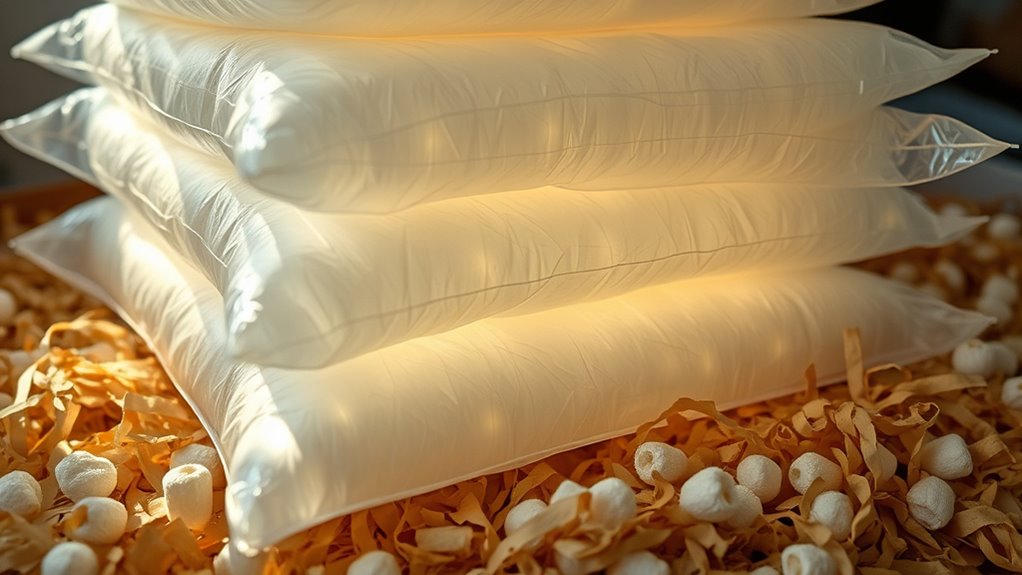
Recyclable air pillows offer a practical and eco-friendly alternative to traditional bubble wrap, helping reduce plastic waste during shipping. These air pillows are made from recyclable materials, allowing you to dispose of them responsibly after use. They are lightweight, which can lower your shipping costs, and provide excellent cushioning for fragile items. When you choose air pillows made from recyclable materials, you support sustainability by decreasing landfill waste and promoting circular use of plastics. Many manufacturers now produce these air pillows with biodegradable or recyclable plastic films, making them a smarter choice for environmentally conscious businesses. By switching to recyclable air pillows, you can protect your products and the planet without sacrificing protection or convenience.
Reusable Fabric Wraps and Cloth Wraps

As more businesses seek sustainable packing options, reusable fabric and cloth wraps have gained popularity for their durability and eco-friendliness. You can master fabric wrapping techniques that protect items while reducing waste. Consider these key tips:
- Choose versatile cloth sleeve designs that fit different shapes and sizes.
- Use simple folding patterns to secure your items tightly and prevent slipping.
- Incorporate washable, sturdy fabrics like linen or cotton for repeated use.
- Opt for sustainable materials to ensure your wraps remain environmentally friendly over time.
- Experiment with reusable fabric wraps that can be customized with patterns and colors, making them both functional and attractive.
These wraps can be customized with patterns and colors, making them both functional and attractive. Reusable fabric wraps not only cut down on single-use plastics but also add a personal touch to your packaging. By adopting these cloth-based solutions, you support sustainability while giving your packaging a unique, eco-conscious flair.
Mushroom-Based Packaging Materials
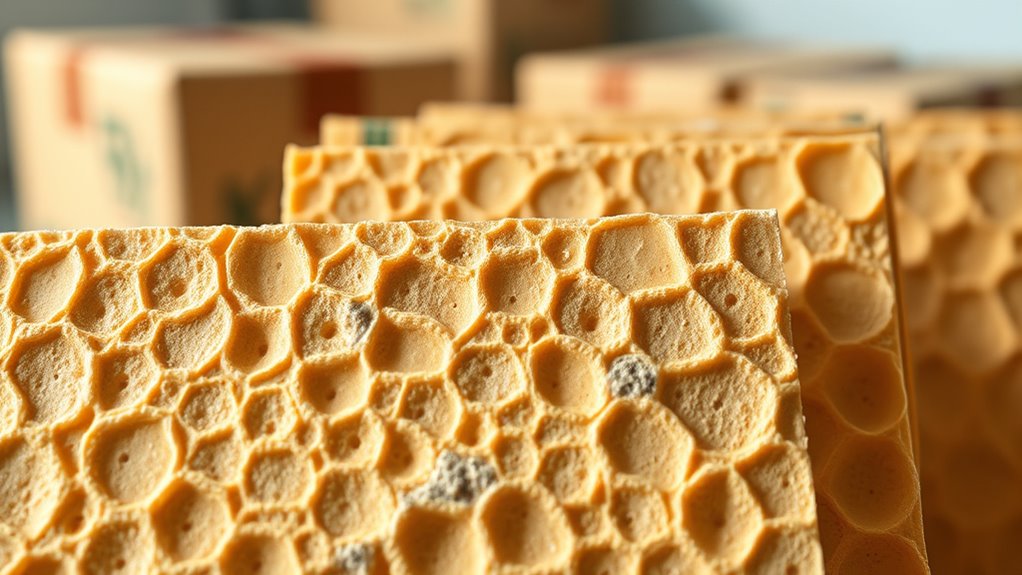
Mushroom-based packaging materials are emerging as a sustainable alternative to traditional packaging options, offering an environmentally friendly way to protect products. Fungi-based packaging utilizes mycelium, the root structure of mushrooms, which can be grown into molds to create sturdy, biodegradable containers. These mushroom fiber applications are versatile and can be customized for various packaging needs, reducing reliance on plastic and foam materials. The process involves combining mushroom mycelium with agricultural waste, which is then cultivated to form dense, lightweight packaging pieces. Not only does this method minimize waste, but it also accelerates decomposition once discarded, leaving no harmful residues. Mushroom-based packaging presents a promising eco-friendly solution that supports waste reduction and promotes sustainability in packaging industries.
Plant-Based Foam Alternatives
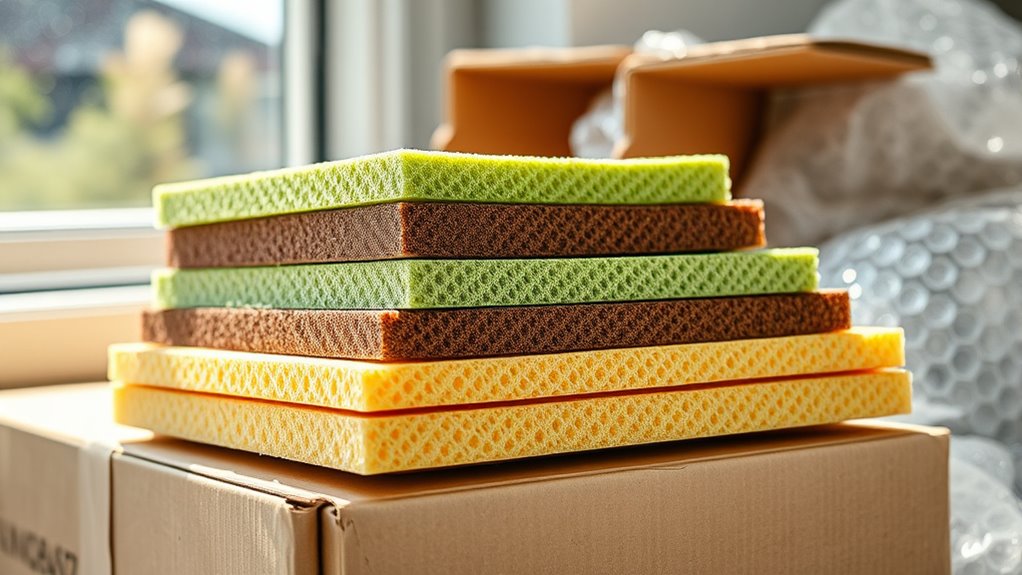
Plant-based foam alternatives offer a biodegradable option that breaks down naturally, reducing landfill waste. They also provide durable protection for your items, matching traditional foams in strength. By choosing these materials, you can considerably lower your environmental impact while maintaining effective packaging.
Biodegradable Material Benefits
Biodegradable, plant-based foam alternatives offer a compelling eco-friendly option for packaging. Their biodegradable material benefits mean they break down naturally, reducing waste in landfills and minimizing environmental impact. When you choose these materials, you’re supporting sustainability in a few key ways:
- They decompose quickly, often within months, unlike traditional plastics that take centuries.
- They come from renewable resources, cutting down reliance on fossil fuels.
- They help promote eco friendly packaging by lowering carbon footprints and decreasing pollution.
Plant-Based Foam Durability
Although plant-based foam alternatives are designed to be environmentally friendly, many people wonder if they can stand up to the durability of traditional packaging materials. The key to their effectiveness lies in plant-based foam properties, which include resilience and shock absorption. These foams often use natural fibers and bio-based binders that provide comparable strength and cushioning. Advances in manufacturing have improved plant-based foam durability, making them suitable for protecting fragile items during transit. While they may not match the longevity of petroleum-based foams in all applications, many options now offer sufficient durability for most shipping needs. As a result, plant-based foam alternatives can serve as reliable, eco-friendly substitutes without sacrificing performance.
Environmental Impact Reduction
Switching to plant-based foam alternatives considerably reduces environmental impact by decreasing reliance on fossil fuels and lowering greenhouse gas emissions. These eco-friendly options help shrink your carbon footprint and cut energy consumption during production. Here are three benefits you’ll notice:
- Lower Carbon Footprint: Plant-based foams absorb CO2 during growth, making their lifecycle more sustainable.
- Reduced Energy Use: Manufacturing plant-based foams consumes less energy compared to traditional petroleum-based options.
- Less Pollution: These alternatives generate fewer harmful emissions, helping improve air quality.
Recyclable Bubble Wrap Films
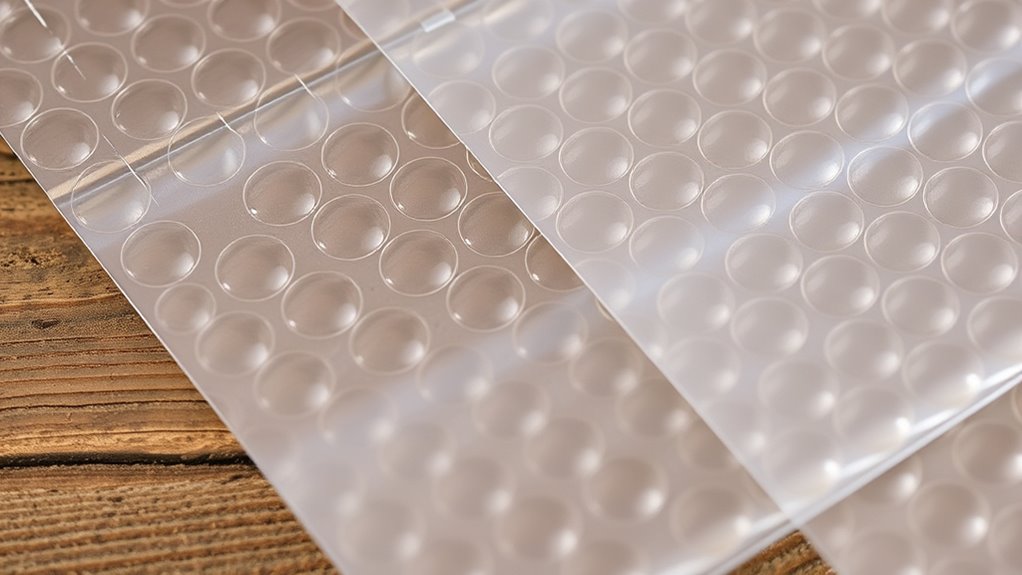
Have you considered how recyclable bubble wrap films can reduce environmental impact? These films are a smart choice for innovative packaging, offering the same protective qualities as traditional bubble wrap but with an eco-friendly twist. Made from recyclable materials like polyethylene, they can be processed and reused, minimizing waste. Using recyclable bubble wrap films helps companies meet sustainability goals and appeal to environmentally conscious consumers. They’re designed to break down more easily at the end of their life cycle, reducing landfill accumulation. By switching to these films, you contribute to a circular economy and promote responsible resource use. Not only do they protect goods during transit, but they also align with your commitment to sustainability through innovative packaging solutions that prioritize eco friendly materials.
Upcycled and Repurposed Packaging Solutions
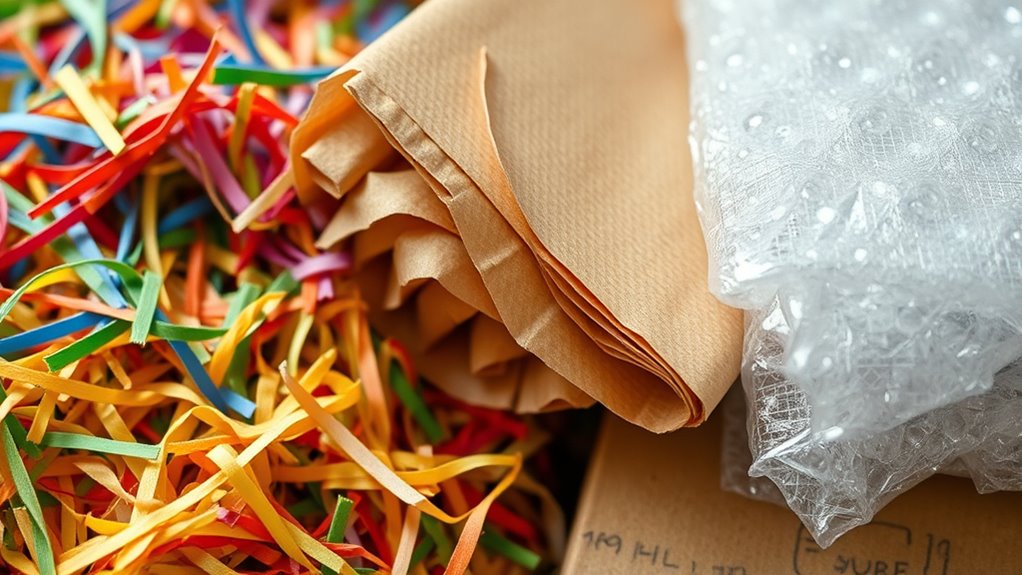
Building on the idea of eco-friendly packaging, upcycled and repurposed solutions turn waste materials into valuable shipping supplies. These options rely on innovative design to maximize durability and protection while reducing waste. You can explore options like:
Upcycled packaging transforms waste into durable, eco-friendly shipping solutions that protect products and reduce landfill waste.
- Using old newspapers or cardboard boxes reinforced with eco-friendly tape for cushioning.
- Transforming fabric scraps into padded wraps or fillers that absorb shocks.
- Repurposing plastic containers or jars as secure, reusable packaging for fragile items.
This approach not only minimizes landfill waste but also streamlines supply chain integration by creating versatile, cost-effective solutions. By adopting upcycled packaging, you support sustainability and demonstrate environmental responsibility, all while maintaining product safety. It’s a smart, innovative way to rethink packaging and reduce your carbon footprint.
Frequently Asked Questions
How Do Biodegradable Packing Peanuts Decompose in Different Environments?
When you ask how biodegradable packing peanuts decompose in different environments, you consider their compostability timelines and environmental impact. In a compost bin, they break down quickly—often within a month—minimizing pollution. In landfills, decomposition slows considerably, possibly taking years, which lessens their eco-benefit. Understanding these timelines helps you make eco-friendly choices, reducing your environmental impact by choosing packing materials that decompose faster and leave less waste behind.
Can Recycled Paper Bubble Wrap Be Reused Multiple Times Effectively?
Think of recycled paper bubble wrap as a gift of renewal. Its reuse potential depends on how well you handle it during the recycling process. If you gently flatten and store it properly, you can reuse it multiple times, extending its life and reducing waste. Its durability symbolizes sustainability, showing that with care, you can maximize its reuse potential, making your packing eco-friendly while giving it a second chance to protect.
Are Molded Pulp Packaging Materials Suitable for All Types of Fragile Items?
You might wonder if molded pulp packaging materials suit all fragile items. Molded pulp durability varies depending on the product, but it generally provides good protection for many items. Packaging mold suitability depends on the item’s shape and weight; it’s excellent for irregularly shaped objects but may not be ideal for very delicate or heavy items. Assess each item’s needs carefully to guarantee ideal protection with molded pulp.
What Are the Cleaning Requirements for Reusable Fabric Wraps?
When caring for reusable fabric wraps, you should focus on fabric care and stain removal. Always follow the manufacturer’s washing instructions, usually machine wash in cold water and gentle cycle. For stain removal, act quickly by dabbing with a mild detergent or stain remover, avoiding harsh chemicals. Air dry or tumble dry on low heat. Proper cleaning sustains fabric integrity and ensures your wraps stay reusable and eco-friendly.
How Do Mushroom-Based Packaging Materials Compare in Durability to Traditional Plastics?
You’ll find mushroom-based packaging materials are quite promising, with durability comparable to traditional plastics in many cases. About 70% of consumers prefer eco-friendly options, boosting demand. During biodegradability testing, mushrooms break down faster than plastics, reducing environmental impact. An environmental impact assessment shows mushroom packaging leaves a smaller carbon footprint. So, while they might need more reinforcement in some uses, they’re a sustainable, durable alternative that’s gaining ground quickly.
Conclusion
By choosing these sustainable alternatives, you can make a real difference and help protect the planet. Don’t let the opportunity slip through your fingers—every small step counts. Switching to biodegradable, recyclable, or upcycled packaging shows you care about the environment and future generations. It’s time to roll up your sleeves and embrace greener choices. After all, it’s not just about packaging; it’s about leaving a better world for those who come after you.
